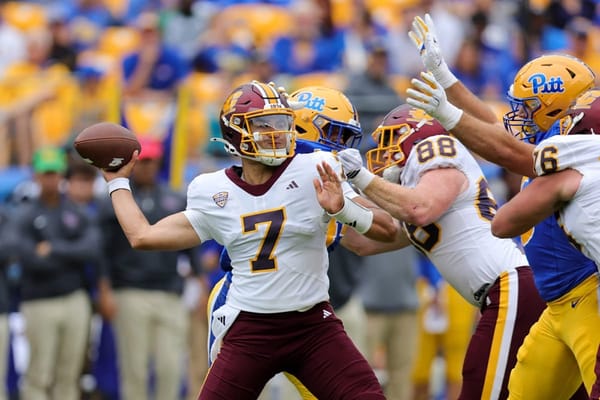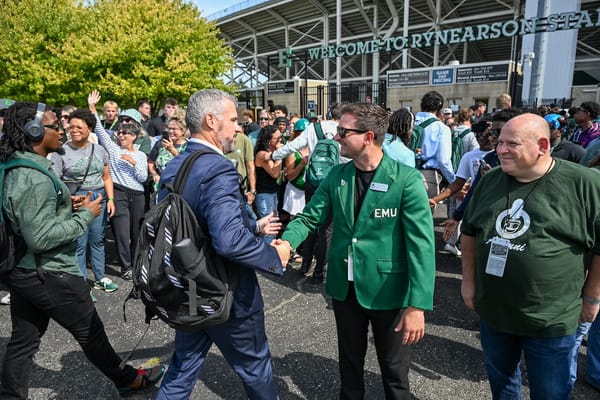Central Michigan's evolving 3 QB offense unlike anything in college football
The Chippewas are doing something unorthodox and relatively unheard of at quarterback, rotating three players in regularly to the offense. And it's working.
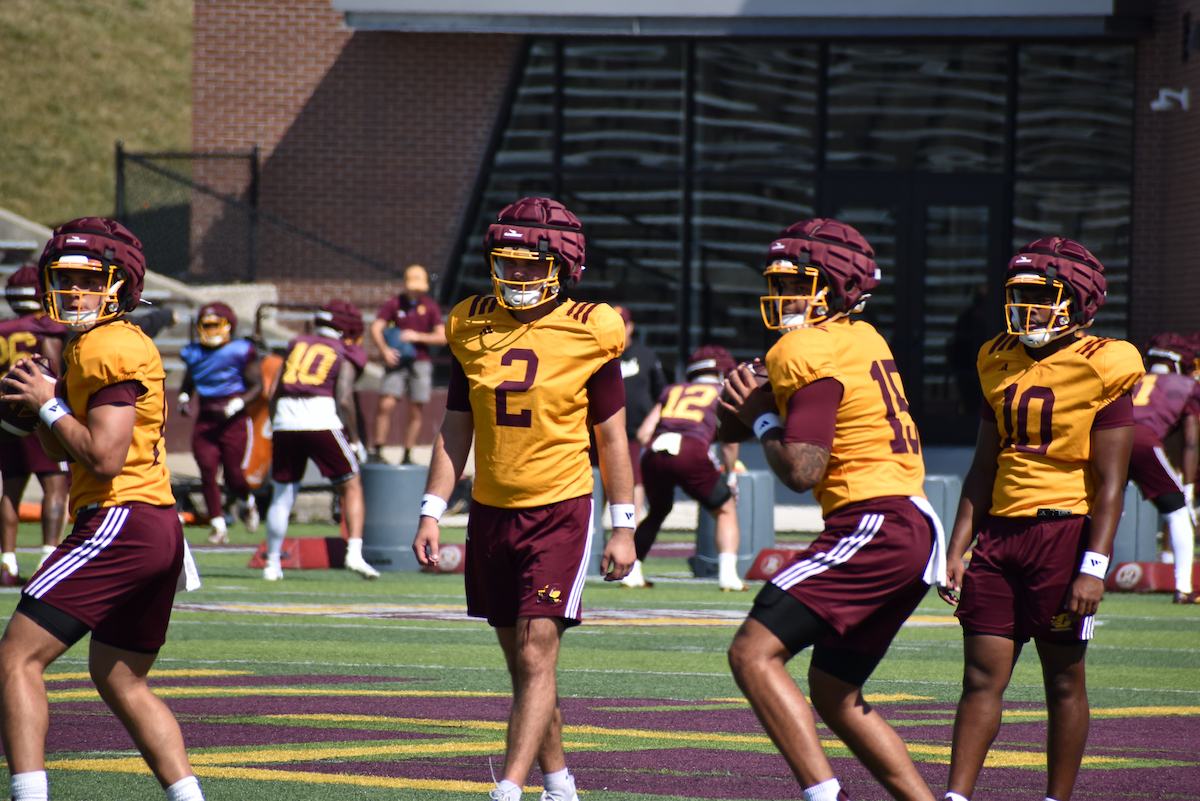
Mt. Pleasant — Matt Drinkall never hid from the possibility, even probability, of playing multiple quarterbacks in 2025.
With a veteran returning starter coming back from an injury, a young backup dripping with physical talent and then two transfers, the Central Michigan head coach had a happy conundrum, with more quarterbacks than starting spots. So the solution was evident.
“But I'm telling you we signed some very, very talented players in recruiting right away that were ready to compete and play, and you will see them play," Drinkall said in August.
Drinkall, though, has taken playing multiple quarterbacks to a logical extreme and in an unorthodox direction that seems to be paying off.
Little else early in the 2025 season is so bold as Central Michigan playing a three-quarterback pro-style power spread offense. Yes, three quarterbacks. And not with tailored packages for two of them. Nor is this a competition running into the season. It’s a conscious choice by Drinkall and offensive coordinator Jim Chapin, borne from practical football considerations that evolved as quarterbacks Joe Labas, Jadyn Glasser and Angel Flores all flourished through the spring and summer. Officially conceived after the second scrimmage of fall camp and debuted in a season-opening upset win over San Jose State, the Chippewas quarterbacking triumvirate takes center stage this weekend when Central Michigan plays Michigan at noon in Michigan Stadium.
And, yes, Drinkall knows this plan is somewhat unhinged.
“It is nerve wracking, because you're like, 'No one else does this.' Well I know this: I am not smarter than anybody. So I am not, we are not figuring out something no one else has figured out. So, that was the scariest part, you don't see other people do this. But part of it is, necessity-wise, you'll start to see some of this more.”
Taking the head coaching job at Central Michigan in December, two of the biggest attractions to the job for Drinkall were the quarterbacks he’d inherit in Labas and Glasser. Both played in 2024 and are “elite” players, according to Drinkall. Labas started six games in 2024 before missing the second half of the season with an injury. Glasser, then a true freshman, started the final four games of the year and still redshirted going into 2025.
Along with getting to work with that duo, the new Chippewas staff added a pair of quarterbacks in the transfer portal in winter that they were high on, Angel Flores from Northern Arizona and Marcus Beamon from Butte College.
Quickly, Drinkall came to think all four could play, as competition picked up in spring.
Drinkall planned all along to use more than one quarterback, likely supplementing Labas as the starter with at least one other quarterback to soak up some carries and hits. The goal, in general, is to keep Labas — who has yet to play a full, healthy college season — on the field for as many snaps possible across the whole season. And the head coach considered a simple calculus: Central Michigan’s offense called for running the quarterback, and Labas had an injury history.
But the calculus changed over the spring and summer as the quarterbacks did, changing the terrain of the position for the better for the Chippewas.
Labas excelled in the weight room and his injury rehab, Drinkall said, transforming his body to be bigger, stronger and more explosive than it’s ever been by the time fall camp rolled around.
“The plan was originally to find some guys who could take a couple, a lot of the hits and the heavy carries off of Joe during the course of the season,” Drinkall said. “Well then Joe got big in the weight room and is like way thicker and more explosive than he's ever been.”
And as Labas put in work to get healthy and make gains in the weight room, all giving coaches more confidence to run him, his counterparts sprouted as passers and operators of the offense. Flores, who arrived in January, started taking to the new system and his natural talents could start to shine through. Beamon also impressed coaches as far back as the spring game, but they opted to redshirt him in 2025 to establish a succession plan at the position.
Glasser perhaps grew the most, as Drinkall said the gifted physical talent grew from being just a bundle of talents with an impressive arm into something more of a quarterback, pairing and harnessing physical abilities while meeting the mental demands of the role.
“Now, if he starts and plays the whole game against Michigan, we trust him with anything,” Drinkall said.
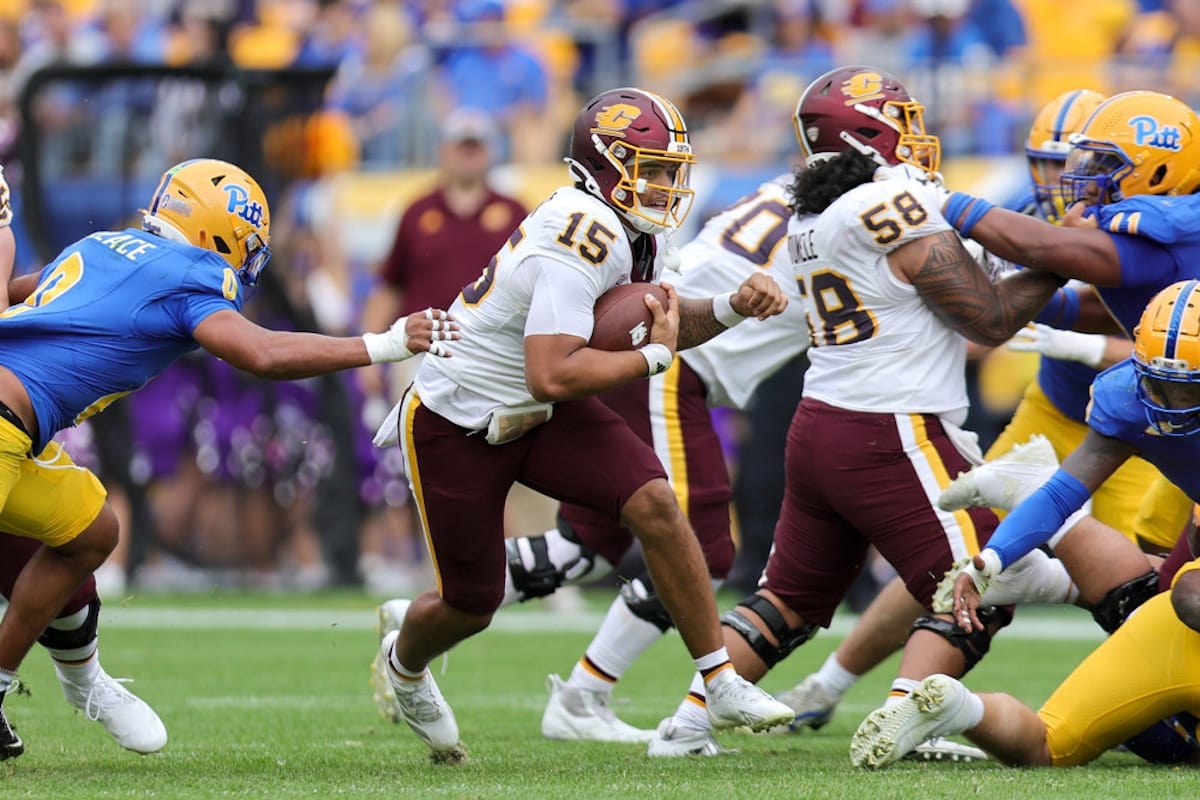
And leading a new coaching staff, Drinkall sat back for much of the offseason and let the quarterbacks rotate through and compete. Labas had a bit of a leg up as the returning starter, but little was set in stone.
So after the second scrimmage of fall camp, about two weeks before the Chippewas opened the season, Drinkall went to Chapin to share a doozy of a thought: We can play three quarterbacks.
“And then we kept getting all the way through camp and I kind of went up to Chapin one day and I was like, 'Hey, are we insane, but like do we have three starters?'” Drinkall said, recalling the moment.
His offensive coordinator was on the same page, as were the quarterbacks themselves.
“And he was like, 'I just said something to the guys today,'” Drinkall said of his conversation with Chapin. “And I was like, 'Alright, well lets start seeing if we can do that in team, see how it goes.' And I guess the day before, the three quarterbacks, before the quarterback meeting started, they were sitting in there and they were like, 'I bet all three of us are going to play.'”
The quarterbacks corroborated that timeline.
“It was like a good feeling that it was probably going to happen,” Glasser said.
He added: “I knew since OTAs that all three of us could play, be the starting quarterback for Central Michigan.”
Chapin himself came to the idea from some of his past experience, coaching at the Division II level and facing an opponent that consistently played and rotated two quarterbacks. He applied the concept as the offensive coordinator at Eastern Washington, playing multiple quarterbacks. He’d seen the benefits of it first hand and started to see the same thing Drinkall saw in the quarterbacks, that all of them could play.
And whether Chapin or Drinkall can take ultimate credit for the quarterback rotation is less important than their mutual acceptance to take on the risks of doing something no one else is doing, really.
For all the fears of this choice potentially chasing players to the transfer portal, tanking an offense and ultimately souring their tenure in Mt. Pleasant with an early gamble gone wrong, the coaches also sensed the benefits if it paid off.
Drinkall and Co. sold the idea to the quarterbacks well, getting buy-in from Labas — who could’ve bristled at sharing the job — on the premise that he’d potentially end up playing more football in the season as a result of the rotation keeping him healthy. Flores and Glasser bought in, too, as they’d get significant real playing time.
And in establishing and maintaining the stability of this rotation at a position normally reserved for one man, the Chippewas found unrelenting honesty has been the best policy. The fact this is a decision that goes against football norms and traditions isn’t a taboo topic, nor is acknowledging that this system is novel and presents its own challenges to navigate, for players and coaches. Having individuals with the right disposition for a rotation helps, too, and Drinkall seems to think that’s the case with this trio.
“Well part of it is, I mean there's a little bit of you're damned if you do and you're damned if you don't, now,” Drinkall said. “Now, the reality of college football, the business side of it, is if you've got a really good player on your team and you play him, somebody else is now going to see him. Well if you sit him, all the people behind closed doors that talk to the kid are going to tell him, 'You're better than this, you should be playing.' So there is no great way to manage it other than to be brutally honest and transparent and talk to the kids about what's going on and what you can expect.”
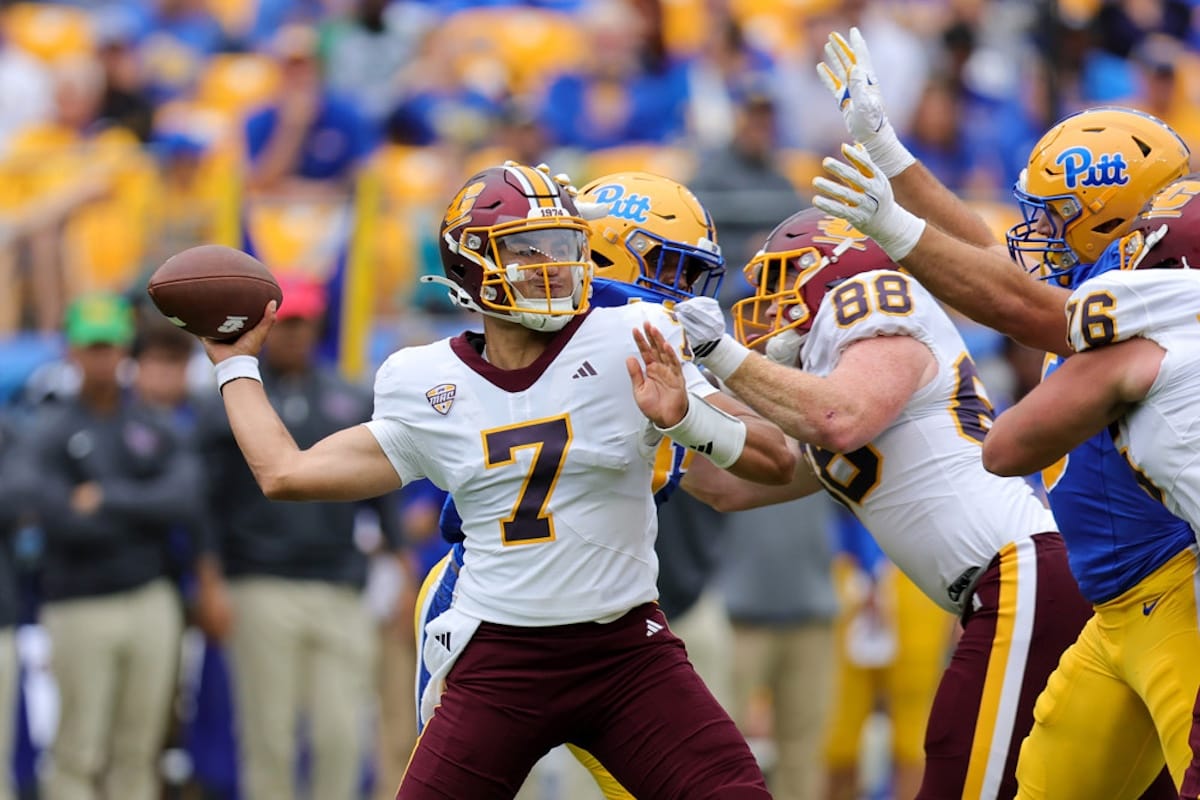
The honesty also crystallizes the fundamental premise of this quarterback rotation: Labas, Glasser and Flores are not just cogs in a machine to win football games, but interchangeable ones.
“I feel like I'm part of a machine, a good machine, a moving machine,” Glasser said.
In being interchangeable, the quarterbacks are all functional operators of a majority of the offense, Drinkall said. This isn’t some situation where one comes in for Wildcat packages and another for short yardage running. All three might be passers, all three could run it, and each has their strengths and tendencies within that.
For as novel as the decision to rotate quarterbacks is, the profundity lies in the simplicity of just applying a three-man rotation to a position that doesn’t normally have one. That’s all this is at the end of the day.
“To have three guys that are like, truly mentally preparing every week like, 'I'm playing. I could be playing a lot, I could be playing on 4th and goal or to start the series,' that is a humongous competitive advantage that I think we continue to invest in,” Drinkall said.
The other benefits of this system for Central Michigan run the gamut.
It inherently builds depth at a critical position and protects Labas, the named starter, from excessive hits and injury risk. It creates increased competition during the week, raising the level of the room. On the field, defenders might not have to account for wholesale schematic shifts, but it forces constant communication, awareness of the quarterback that’s in the game and their tendencies.
And sometimes using those tendencies makes sense, like when Glasser entered and converted a key 4th and 1 from the Central Michigan 29 yard line in the opener against San Jose State.
Those tendencies can just as easily be weaponized, as Central Michigan showed against Pitt in Week 2. Glasser entered the game with the Chippewas offense just past midfield in the first half, lining up in the shotgun in a 14 personnel package (one running back, four tight ends).
In a dense formation, and having mostly been used as a runner the week before, the Pitt defense over-indexed for run, so a safety remained flat footed with eyes in the backfield as tight end DeCorion Temple rumbled past him deep for a wide open touchdown pass, which Glasser overthrew.
“Everyone in the stadium, you get 14 personnel, and Jadyn Glasser goes in and 'Here comes a short yardage run,' Chapin said. “And here comes a shot. We know those things, and sometimes that can be even more powerful. Because if there's going to be wholesale defensive decisions, we know all three quarterbacks can do it all.”
Risks with this gambit are real, too.
The coaching staff could’ve sold the plan to the quarterbacks poorly, or made the decision when the group of players wasn’t the right mix, and had discontent in the ranks from the start. The quarterbacks themselves are learning how to handle shuttling in and out of the game and staying engaged, mentally.
And in a situation where playing time is variable, Drinkall knows there could be a temptation for any one of his quarterbacks to want to play the hero when they get a chance on a proverbial 3rd and long. There, again, the brutal honesty comes into play — the coaching staff needs the quarterbacks to stay within themselves and the offense, and everyone knows it.
“So, the downside is, you have three kids that are all fighting for playing time and if you manage that poorly, all of a sudden you call a pass play on 3rd and 21 — 'This is my time to shine, I want to be a hero,' and they throw a bad pick,” Drinkall said. “So you have to be totally — you have to talk about that, a lot, and get that out in the open so the kids make good choices.”
So far in 2025, the pitfalls have mostly been avoided as the Chippewas are 1-1 heading into Week 3.
In two games, Labas has played 66 snaps, Flores 40 and Glasser 27. Drinkall said after Week 1, when Glasser played just seven snaps, that he wanted to play him more. Then got him 20 snaps in Week 2, five more than Flores. Labas has led the team in snaps at QB both weeks.
And the second half against Pitt is close to the balance the Chippewas want to strike, in terms of how the offense looks running and throwing the ball. Labas had 22 snaps in that half, Flores took eight and Glasser had 11. And in the whole game, all three ran it and threw it and all three contributed to touchdown drives in some capacity.
The early returns are good, as Central Michigan irons out the wrinkles and inevitably tailors weekly game plans more around some quarterbacks than others. And the evolution isn’t over, as Drinkall and Chapin have both alluded to getting two quarterbacks on the field at one time, though they are tight lipped about when and how.
It might not be this Saturday in Ann Arbor, but the Wolverines and millions of Michiganders tuning in on Big Ten Network at noon will likely take their first look at a college football offense that is novel, doing something no one else is doing, and seems to be a success.
And all that really changed is rotating one position.
"So, we're going to go play, and those guys are going to sort it out,” Chapin said.
